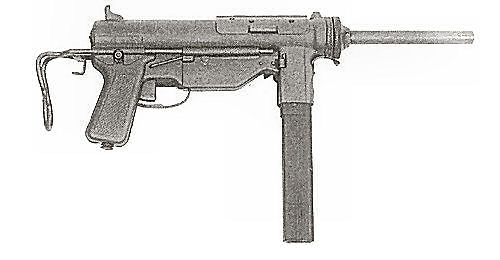| Adoption of the M3/M3A1 relegated the Thompson submachine gun to "Limited Standard" or "Substitute Standard."
The widespread use of the Thompson was due mainly to the fact that it was the only allied submachine gun in mass production at the beginning of WWII. It had several weaknesses; e.g. weight and control. The Sten, for example, which was of stamped and welded metal construction and finished with a paint-like coating, scored higher than the Thompson when such things as simplicity, accuracy, weight and reliability were measured. The .45 caliber M3 was an automatic, air-cooled blowback-operated weapon that fired from an open bolt. When the trigger is pulled, the bolt is driven forward by the recoil springs, stripping a round from the feed lips of the magazine and guiding the round into the chamber. The bolt then continues forward and the firing pin strikes the cartridge primer, igniting the round, resulting in a high-pressure impulse, forcing the bolt back against the resistance of the recoil springs and the inertial mass of the bolt. By the time the bolt and empty casing have moved far enough to the rear to open the chamber, the bullet has left the barrel and pressure in the barrel has dropped to a safe level. The low cyclic rate was a function of the low pressure generated by the .45 ACP round, a heavy bolt, and recoil springs with a lighter-than-normal compression rate. The M3A1 is an improved, simplified variant of the M3. Both are far easier to manufacture than the Thompson, and have a number of excellent design features in addition. The low cyclical rate of fire makes the gun easier to control than most submachine guns, not only the Thompson. The weapon's straight line of recoil thrust also adds substantially in controlling the gun in automatic fire. The gun's loose tolerances allow for reliable operation even if very dirty and, with its bolt and guide rod design make it more reliable than the Thompson under adverse conditions. The M3 and M3A1 submachine gun have no mechanical means of locking the trigger. When the magazine has been emptied, the bolt will close on the empty chamber. Inserting a loaded magazine loads the gun. If the cover is open and the bolt cocked, pressure on the trigger will fire the gun. If an unlocked gun is dropped, it may fire whether the bolt is cocked or not. |


